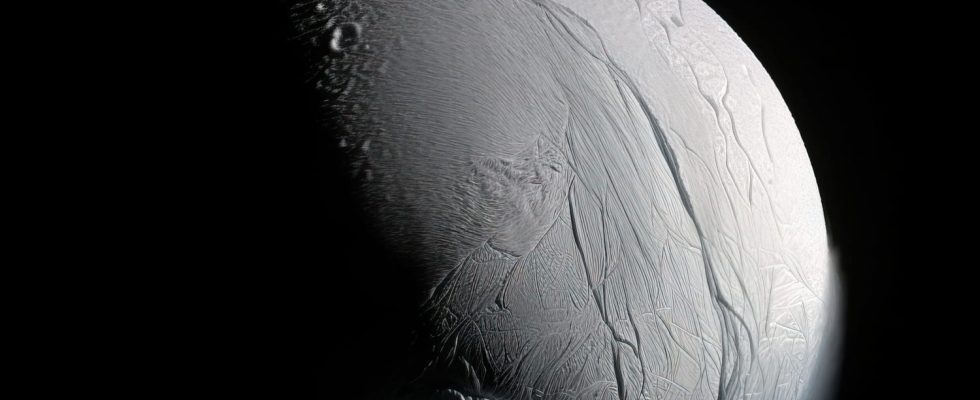SATURN. By studying data from the Cassini space probe, researchers discovered the presence of phosphorus on a moon of Saturn: Enceladus. The icy star therefore houses the six essential elements for the emergence of life.
Five years after its last great plunge towards the ringed planet, the Cassini space probe has not finished giving us information about Saturn and its moons. Indeed, scientists continue to study the data collected by the spacecraft during its mission. Published in the scientific journal Nature, a new study reveals that the moon icy Saturn, Enceladus, contains phosphorus, a key element essential to life as we know it. If we had already discovered the presence of the five other elements essential to life on the star, this is the first time that phosphorus has been detected there.
Considered one of the places most likely to support life outside of Earth, Enceladus is a moon containing an ocean hidden under a thick layer of ice. Spectacular geysers escape from it, feeding a ring of the planet as they pass and forming superb plumes of steam around the star. We now know that this ocean contains the six elements essential to life: carbon, hydrogen, nitrogen, oxygen, phosphorus and sulphur. It remains to be discovered whether this habitable ocean is actually inhabited or not…
What discovery on Enceladus?
Enceladus, a small moon of Saturn is undoubtedly one of the most fascinating stars we know. A veritable little frozen sphere, the satellite encloses an ocean under its icy crust and intrigues scientists. Indeed, the six elements necessary for life have been detected in this ocean. It was the Cassini probe, which flew over Saturn and its moons between 2004 and 2017, which made this discovery possible thanks to the numerous data it collected and which are currently being studied by astronomers.
Enceladus therefore has the only known extraterrestrial ocean containing the elements necessary for the emergence of life in the form we know. The quest for life forms outside our planet has therefore taken a big step with this discovery. To learn more, we will have to return to study more closely this small frozen moon located more than 1.27 billion kilometers from Earth.
What are the peculiarities of the planet Saturn?
Discovered by Galileo in 1610, Saturn is a planet that does not go unnoticed. Decorated with a multitude of superb rings, it constitutes a fascinating object of study for astronomers who are passionate about this extraordinary gas giant. With 145 recognized satellites, this is the planet of solar system possessing the most moons orbiting around it. It is also the least dense planet in the solar system. 8 times less dense than the Earth, it would float in a (very large) bathtub filled with water.
In addition to its characteristic rings, Saturn also sports a surprising geometric pattern, discovered by the Voyager probe and photographed by the Cassini probe. It’s actually a hexagonal-shaped storm raging at the planet’s north pole. Its size is as disproportionate as the planet that hosts it since this storm could accommodate three times the Earth in its width.
Finally, Saturn also stands out for its shape with flattened poles. It is its gaseous and therefore fluid nature that leads to a deformation of the sphere under the effect of the particularly rapid rotation speed of the planet.
How many satellites does Saturn have?
With 145 confirmed moons, Saturn is the planet in the solar system with the most satellites. If some like Tethys, Mimas or Rhea are known to astronomy enthusiasts, the main ones remain Titan and Enceladus. The latter have fascinated researchers for several decades and alone have become the subject of entire research projects.
If Saturn has so many satellites, it is mainly because of its large size which implies a great force of gravity. In the same way as Jupiter, Saturn thus attracts bodies that pass nearby. It happens that the latter are placed in orbit around the planet and become satellites.
The largest of Saturn’s satellites is Titan, which has a diameter of 5,149 kilometers, making it one of the few moons larger than the planet Mercury. Titan is known to be the only satellite in the solar system to have a thick atmosphere. It is also dotted with lakes filled with liquid methane.
Enceladus is a frozen world, covered in ice. The Cassini probe, which approached this moon, captured images of geysers projecting water ice particles hundreds of kilometers away. This discovery opened the way to many theories concerning the possibility of the emergence of a form of life within an ocean located under the ice covering Enceladus. Future space missions could teach us more about these hypotheses.
What is Saturn’s position in the solar system?
Within the solar system, Saturn sits between the planets Jupiter and Uranus. It is therefore located in 6e position in the order of the planets starting from the Sun. It is part of the outer solar system along with Jupiter, Uranus and Neptune.

